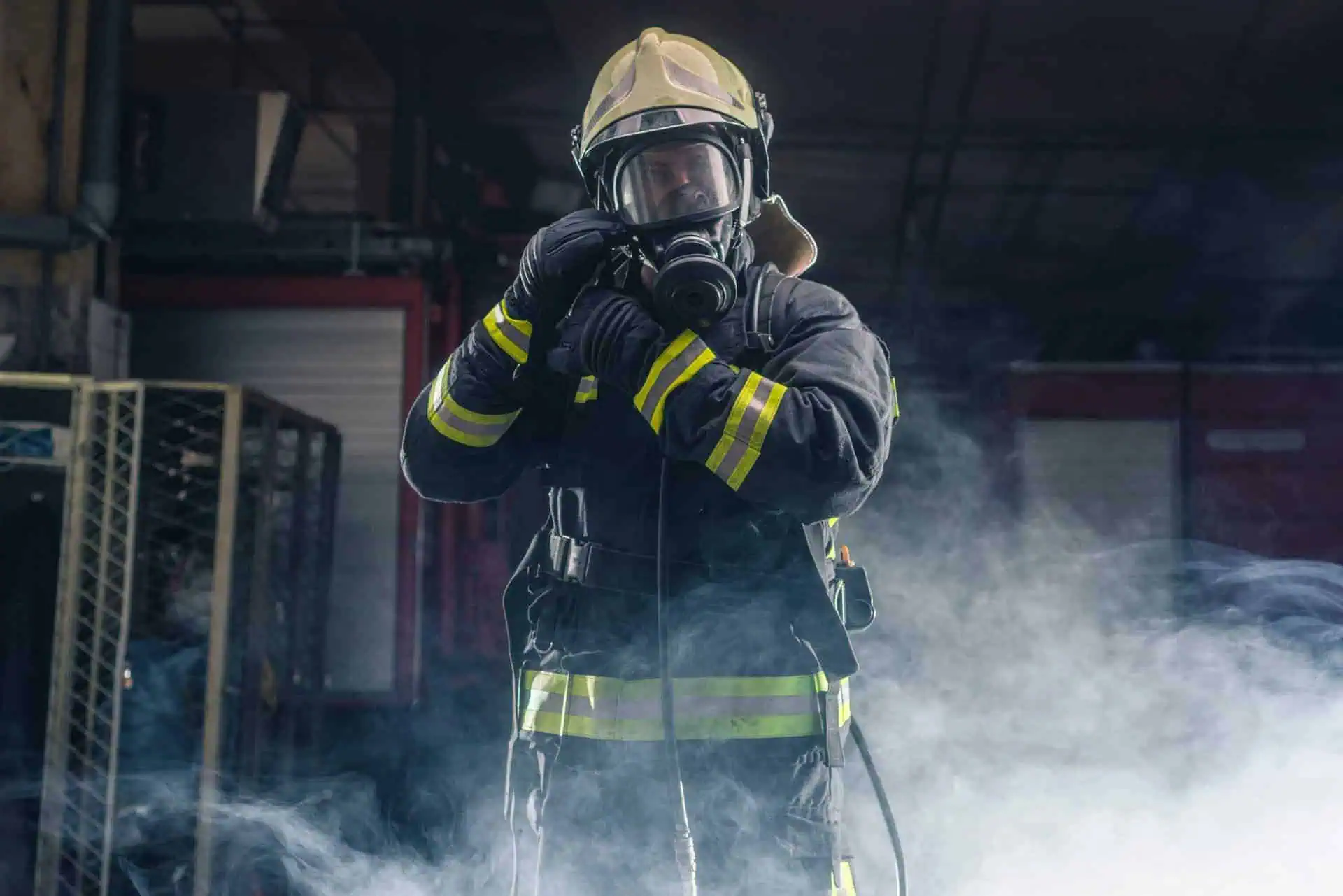Firefighter Gear Lawsuit | Turnout Gear Cancer Attorneys
- Last Updated: July 14th, 2025
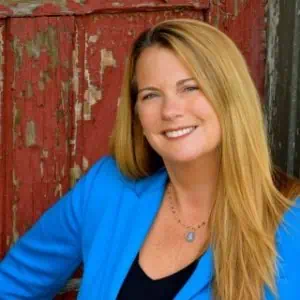
Attorney Jessica Paluch-Hoerman, founder of TruLaw, has over 28 years of experience as a personal injury and mass tort attorney, and previously worked as an international tax attorney at Deloitte. Jessie collaborates with attorneys nationwide — enabling her to share reliable, up-to-date legal information with our readers.
Legally Reviewed
This article has been written and reviewed for legal accuracy and clarity by the team of writers and legal experts at TruLaw and is as accurate as possible. This content should not be taken as legal advice from an attorney. If you would like to learn more about our owner and experienced injury lawyer, Jessie Paluch, you can do so here.
Fact-Checked
TruLaw does everything possible to make sure the information in this article is up to date and accurate. If you need specific legal advice about your case, contact us by using the chat on the bottom of this page. This article should not be taken as advice from an attorney.
Key takeaways:
- Firefighters face significant health risks due to PFAS exposure from their protective gear, including increased risk of various cancers, suppressed immune function, hormone disruption, and elevated cholesterol.
- Efforts to remove PFAS from firefighter gear have been unsuccessful, highlighting the need for continued advocacy, collaboration with regulatory bodies, and the development of safer alternatives that meet necessary fire service safety standards.
- Firefighters can take preventative measures to reduce their exposure to PFAS, such as only wearing turnout gear when essential, treating PPE with respect, keeping gear separate from living areas, and washing gear before wearing it.
Overview of PFAS Firefighter Gear Lawsuit
On this page, we’ll discuss the PFAS firefighter gear lawsuit, the potential health consequences of PFAS exposure for firefighters, efforts to develop PFAS-free firefighting equipment, and much more.
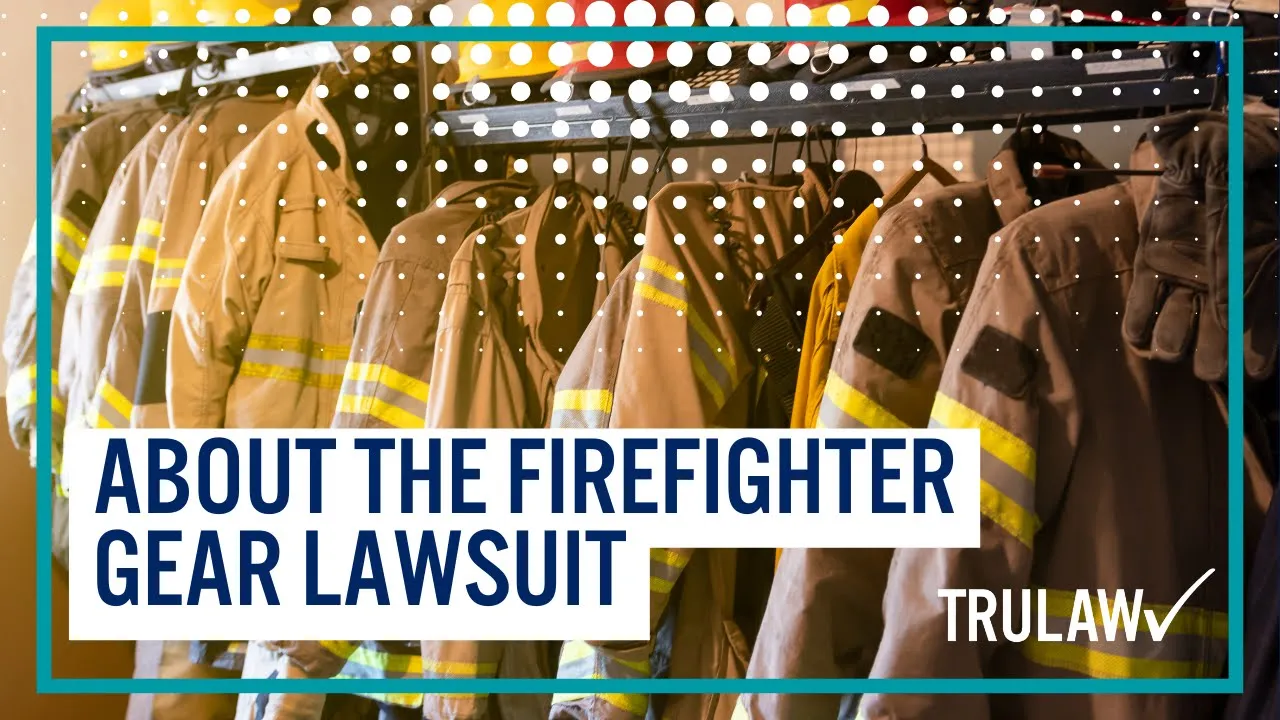
Intro to the PFAS Firefighter Gear Lawsuit
The main issues related to PFAS in firefighter gear include, but are not limited to:
- Prevalence of PFAS: PFAS chemicals have been widely used in the manufacturing of firefighter gear due to their water-resistant and flame-retardant properties.
- Firefighter Health Concerns: Prolonged exposure to PFAS has been associated with increased risk of certain cancers and other health problems among firefighters.
- Inadequate Safety Measures: Critics argue that firefighters have not been adequately informed about the risks of PFAS exposure or provided sufficient protective measures.
- Alternatives and Regulations: There is a growing push to develop PFAS-free firefighter gear and implement stricter regulations on using PFAS in firefighter gear.
If you are a firefighter who has developed health issues potentially related to PFAS exposure from firefighter gear, you may have legal options for seeking compensation.
Contact TruLaw using the chat on this page to receive a free case review and learn more about your eligibility to file a PFAS firefighter gear lawsuit.
Table of Contents

Firefighter Turnout Gear Lawsuit Updates Timeline
Since the previous month, over 450 new lawsuits were filed in the AFFF multi-district litigation (MDL), starting February 2025 with now over 8,000 pending lawsuits.
This number is expected to increase as more firefighters and their families become aware of the AFFF litigation.
By mid-month, 3M, DuPont, and a number of other AFFF manufacturers were sued by Santa Clara County, California, which alleges that said companies are responsible for “contribut[ing] to a serious environmental and public health crisis” through the discharge produced by aqueous film-forming foam.
The county maintains that AFFF linked to the companies has polluted natural resources in the region, “including municipal drinking water supplies, as well as municipal groundwater, reservoirs and other surface waters, stormwater, wastewater, soils, and other properties and equipment.”
At the start of January, the AFFF firefighting foam MDL recorded a total of 7,633 pending cases, with 270 new cases having been added in December.
The total number of cases includes a number of firefighter turnout gear lawsuits.
A recent study sheds light on the neurological impact of PFAS compounds, offering valuable evidence for AFFF litigation.
Researchers examined six PFAS chemicals, showing their ability to disrupt gene expression tied to synaptic growth, neural function, and stress responses.
These findings link PFAS exposure to cognitive decline and memory impairment.
The study also revealed PFAS-induced lipid imbalances, which compromise neuronal integrity.
This new research provides a powerful tool to demonstrate the molecular mechanisms behind PFAS-related injuries, and juries can now refer to clear scientific evidence of the harm suffered by victims, such as firefighters and other exposed individuals.
At the start of the month, the Aqueous Film Forming Foam (AFFF) MDL, which includes a number of firefighter turnout gear lawsuits, recorded a total of 7,370 pending cases.
For Tier 2 Group A cases, fact discovery continues until December 16, 2024, and expert report exchanges and depositions are anticipated to conclude by May 14, 2025.
The first trial begins October 6, 2025, with Group A designations and motions due April 2025. Summary judgment and Daubert motions are expected by June 6, 2025.
For Group B cases, fact discovery remains open through March 17, 2025, as preparations continue for expert schedules related to thyroid and ulcerative colitis claims.
Negotiations on trial-ready cases remain ongoing.
U.S. District Judge Richard M. Gergel issued a significant order in the ongoing AFFF (aqueous film-forming foam) litigation.
Judge Gergel acknowledged the challenge of identifying specific AFFF products used at each military base implicated in the lawsuit.
In an effort to streamline the process, he instructed the parties to designate 15 representative sites out of the many military locations affected by PFAS contamination.
This group of sites will undergo detailed examination to ensure that a range of AFFF products linked to contamination is accounted for.
This approach aims to establish a comprehensive basis for assessing PFAS contamination and its health impacts on communities around military bases.
The AFFF federal multi-district litigation (MDL) continued to expand last month as 7 new lawsuits, originally filed in state courts, consolidated in federal court by October 29, 2024.
This development is attributed to an increased awareness of the health risks associated with PFAS chemicals in firefighting foam.
A new lawsuit filed by a Texas plaintiff claims long-term exposure to PFAS in firefighting foam during a Navy career led to a thyroid cancer diagnosis and other severe health complications.
The case, part of the MDL, targets companies like 3M, Chemours, and DuPont for manufacturing PFAS-laden AFFF products that allegedly caused these harmful health impacts.
In the journey toward the first personal injury bellwether trials, the court has issued a new case management order for the trial pool cases.
The order sets out the schedule for discovery, expert witness exchanges, and trial preparations, moving us closer to securing justice for our clients and potentially reaching a global settlement.
For Tier 2 Group A cases, both sides will continue fact-finding efforts until December 16, 2024, with specific guidelines to streamline discovery.
Following this, expert reports will be exchanged, with depositions wrapping up by May 14, 2025.
The first Group A trial is scheduled to begin on October 6, 2025.
In the coming months, parties will negotiate which Group A cases proceed to trial, with designations and motions due by April 2025.
Any summary judgment or Daubert motions must be filed by June 6, 2025, with responses following in July.
Fact discovery for Group B cases will continue through March 17, 2025, as we prepare expert schedules for thyroid and ulcerative colitis claims by December 2024.
After 320 new cases were added to the MDL in September, the total number of pending cases has risen to 9,896.
We continue to see significant developments in the AFFF litigation.
A North Carolina man filed a new lawsuit in the MDL, alleging that AFFF products containing PFAS caused him to develop kidney cancer.
The plaintiff, an Elizabethtown resident, claims exposure occurred during his firefighting training in Virginia.
He also alleges that these chemicals contaminated the local water supply, which he consumed for years.
The lawsuit names manufacturers such as 3M and DuPont, accusing them of negligence and fraudulent concealment regarding the risks of PFAS.
He seeks compensatory and punitive damages for his injuries and related expenses.
This week, the court issued a new case management order to streamline depositions for the upcoming Tier Two Personal Injury Bellwether Trials.
The order addresses that not all potential witnesses had undergone depositions during the fact discovery phase.
If either side adds a previously undeposed witness to their trial list, the opposing side can request a deposition within 14 days of receiving that list.
The first Telomer Water Provider lawsuit is set to begin on March 3, 2025.
These cases, unique due to their production through telomerization, have garnered significant attention, especially as they were excluded from last year’s major settlement involving 3M.
Their outcomes may influence resources and focus on individual firefighter cancer claims, likely through a settlement once resolved.
The AFFF class action MDL experienced a significant increase in cases, adding over 500 new claims in August after a decline in July.
The total number of pending cases now stands at 9,576, indicating ongoing challenges for those involved in the litigation.
A new lawsuit, Zub v. 3M Company et al., has been filed in connection with aqueous film-forming foam (AFFF) exposure.
The plaintiff, seeking justice for her late husband, has initiated a wrongful death and survival action.
Her husband, a firefighter and hazardous materials technician in Union County, New Jersey, was regularly exposed to AFFF during his career.
The lawsuit alleges that his prolonged exposure to PFAS-containing AFFF led to the development of kidney cancer, ultimately causing his death at the age of 35.
The plaintiff contends that the defendants knowingly designed, manufactured, and distributed AFFF products with PFAS without providing adequate warnings or safety instructions.
Furthermore, the suit claims that the defendants were aware of the hazardous nature of PFAS but chose to conceal this information, preventing her husband and others from recognizing the risks involved.
These allegations highlight the defendants’ fraudulent concealment and negligence.
From July to August 2024, there was a notable decrease in the number of active cases in the Aqueous Film-Forming Foams Products Liability Litigation.
The active lawsuits dropped from 9,525 in July to 9,198 in August, marking a reduction of 327 cases.
This decline is largely due to settlements in water contamination lawsuits, which positively impacts the ongoing personal injury lawsuits related to AFFF.
As these cases continue to be resolved, it sets a promising precedent for future claims.
Tyco Fire Products has reached a preliminary settlement with major insurers, including AIG Insurers, concerning insurance coverage for PFAS contamination liabilities from firefighting foam.
This agreement, outlined in a binding term sheet, will soon be formalized in a written agreement.
Upon finalization, Tyco will dismiss AIG from the litigation with prejudice.
This settlement is advantageous for victims of PFAS contamination as it strengthens Tyco’s ability to meet financial obligations in a $750 million settlement with drinking water systems.
This bolsters Tyco’s position to make significant contributions to a global AFFF firefighting foam settlement in the future.
The docket in the AFFF class action MDL has recently seen a surge in voluntary dismissal notices.
Typically, a notice of voluntary dismissal indicates that the case has been settled, although specifics remain confidential at this stage.
This trend suggests that numerous cases are being resolved, which could be a positive sign for ongoing litigation efforts.
In a significant development on July 22, 2024, Judge Gergel advanced the AFFF litigation by selecting nine cases proposed by the plaintiffs to proceed as bellwether trials.
These cases involve Pennsylvania residents with kidney or testicular cancer and Colorado residents with thyroid cancer or ulcerative colitis, all allegedly linked to exposure to aqueous film forming foam.
The court’s decision largely aligned with the plaintiffs’ proposal outlined in the update from July 17, 2024, which aimed to streamline the litigation process and focus on specific types of cases to expedite proceedings.
The defendants had presented a different set of cases, arguing for a broader representation based on gender, age, and exposure period.
However, the court favored the plaintiffs’ approach, signaling a positive development for the claimants.
In a strategic move to streamline the AFFF lawsuits and alleviate the burden on the court and involved parties, attorneys representing the victims have recommended focusing on specific types of cases.
By selecting kidney and testicular cancer cases from Pennsylvania and thyroid disease and ulcerative colitis cases from Colorado, the aim is to reduce the number of necessary depositions, expert reports, and evidence, thus expediting the legal process.
This proactive strategy seeks to secure multiple trial dates to advance the resolution of these cases efficiently, despite potential opposition from the defendants who may seek to delay trial proceedings.
A recent AFFF lawsuit was filed on July 11, 2024, on behalf of a former Georgia firefighter diagnosed with kidney cancer.
The plaintiff, a Navy veteran who served at Memphis Naval Station, alleges that his exposure to PFAS-containing materials during firefighting activities led to his cancer diagnosis.
This case underscores the ongoing impact of PFAS exposure on individuals involved in firefighting operations.
In a proactive step towards eliminating PFAS in firefighting activities, the Department of the Air Force has initiated the replacement of AFFF stocks with a new fluorine-free formulation (F3).
This transition, part of a broader Defense Department effort, aims to reduce the environmental and health risks associated with PFAS exposure.
The allocation of $8.55 million for the purchase of F3 signifies a commitment to safeguarding personnel and the environment from harmful chemicals.
The number of active AFFF lawsuits has shown a notable increase, reflecting growing concerns over the health effects of PFAS exposure.
With the total count rising from 8,270 to 9,198, individuals across various locations continue to seek legal recourse for alleged injuries linked to AFFF exposure.
These cases highlight the urgency of addressing the impact of PFAS-containing materials on public health and safety.
In a recent development, a new lawsuit was filed on Friday within the MDL on behalf of an Alabama man who worked as a career firefighter and was routinely exposed to AFFF.
Allegedly, as a consequence of this exposure, the Plaintiff was diagnosed with leukemia.
During the month of May, over 250 new cases were added to the AFFF firefighting foam class action MDL, slightly fewer than the previous month.
The total number of cases pending in the MDL has now reached 8,270.
Researchers conducted a study using in vitro 3D human skin equivalent models to analyze the absorption of 17 different PFAS when applied to the skin.
They discovered that shorter-chain PFAS exhibited higher absorption rates, while absorption decreased as the carbon chain length of the compounds increased.
Importantly, although longer-chain PFAS were not directly absorbed into the skin, a significant amount of these chemicals was retained within the skin tissue, with the potential for gradual release into the body over time.
The study also emphasized the impact of physicochemical properties on the dermal permeation of PFAS, revealing a clear inverse correlation between the lipophilicity of the substances and their absorption through the skin.
For experts representing plaintiffs in AFFF firefighting foam lawsuits, this study offers a valuable new resource.
The thorough examination of PFAS absorption through the skin validates the notion that dermal exposure to these chemicals can substantially contribute to the body’s PFAS burden.
This finding holds particular significance in cases involving individuals exposed to firefighting foams containing PFAS.
It establishes a scientifically supported pathway of exposure that directly links PFAS-containing products to the various health issues experienced by firefighters.
Such evidence further bolsters claims that manufacturers such as 3M should have been aware of and warned against the risks associated with dermal exposure to PFAS.
Following CMO 26C, both parties have devised a process for selecting plaintiffs for initial personal injury and wrongful death bellwether trials.
A rough outline of procedures and schedules has been established for managing two groups of plaintiffs alleging kidney cancer, testicular cancer, thyroid disease, and ulcerative colitis.
This structured approach aims to streamline discovery, expert testimony, motion practice, and trial preparations for these groups.
Today marked the deadline for AFFF foam lawyers on both sides to submit their proposals for a Case Management Order concerning Tier 2 Personal Injury Bellwether proceedings.
This deadline followed two extensions and has generated anticipation among many as to which diseases will be included in Tier 2.
The AFFF firefighting foam class action MDL has seen consistent growth, with 323 new AFFF cases added during April.
While this is a decrease from the 568 new cases added in March, it signifies a notable expansion, bringing the total number of pending cases in the MDL to over 8,000.
Our team remains committed to navigating this evolving landscape to advocate for our clients effectively.
Lawyers representing both sides in the AFFF litigation have submitted a joint motion requesting a brief extension for the submission of a proposed Case Management Order concerning Tier 2 Personal Injury Bellwether proceedings.
This motion seeks an additional fifteen days, setting a new deadline of April 24, 2024.
The extension is pursued to foster negotiation and potential consensus on the terms outlined within the proposed order, without altering existing deadlines in the litigation timeline.
A dispute involving AIG insurance groups, Lexington Insurance, National Union Fire Insurance, and Century Indemnity Co. regarding coverage for Kidde-Fenwal Inc. (KFI) lawsuits has emerged.
The AIG groups argue for arbitration concerning a “pollution exclusion” in their contract, while Century Indemnity contends that the lawsuits fall outside the insurance coverage period.
KFI, navigating Chapter 11 bankruptcy, asserts that the matter should be resolved in bankruptcy court rather than through arbitration.
A joint motion filed in the firefighting foam lawsuit aims to streamline the management of individual personal injury cases not covered under Case Management Order (CMO) 26.
It seeks to identify diseases linked to AFFF exposure, organize a Science Day for expert presentations, discuss bellwether case selection, and outline Daubert and dispositive motions plans.
Additionally, the motion imposes specific requirements on Plaintiffs asserting claims not covered by previous CMOs.
In non-MDL AFFF news, a Massachusetts judge has ruled in favor of the International Association of Fire Fighters (IAFF) ‘s lawsuit against the National Fire Protection Association Inc. (NFPA).
The lawsuit alleges unfair or deceptive practices and negligence in NFPA’s fire safety standards requiring the use of carcinogenic chemicals.
Last month saw a notable surge in the AFFF firefighting foam class action MDL, with 568 new cases added, marking the highest monthly volume in over a year.
The total pending cases in the MDL now stand at 7,738.
Case Management Order #28 sparks progress by outlining steps for exchanging scientific studies on AFFF diseases beyond water contamination suits, leading to the crucial AFFF Science Day.
This event educates the MDL judge on scientific nuances, aiding informed decision-making.
Bellwether case selection follows, with proposals due 60 days post-Science Day.
Spring 2024 marks a shift towards personal injury claims in AFFF litigation.
Testicular and kidney cancers emerge as primary concerns, expected to drive significant settlement claims.
Explore our videos for insights on these key cases and anticipated settlements.
Turnout gear PFAS claims gain prominence in AFFF litigation discussions.
Allegations center on health issues stemming from exposure to PFAS in firefighter protective gear.
Case Management Order No. 5F introduces structured procedures for managing Plaintiff Fact Sheets specific to turnout gear claims.
Despite a prior settlement addressing water contamination cases, AFFF litigation remains robust.
Adding 176 new cases last month brings the total count to over 7,000, underscoring ongoing momentum in our pursuit of justice.
The federal judge overseeing the case praised 3M Co.’s proposal to settle with public water systems for over $10.5 billion, addressing PFAS contamination concerns for approximately 12,000 public water systems.
This settlement proposal could impact negotiations in AFFF lawsuits, where concerns about 3M’s potential bankruptcy due to PFAS claims loom large.
In January, 279 new cases were added to the AFFF firefighting foam class action MDL, bringing the total pending cases to 6,994.
Attorneys handling AFFF cases are expediting filings to strengthen their position for potential settlements.
The MDL judge has approved a joint motion to extend the deadline for parties to engage in discussions regarding an ongoing discovery dispute and a motion to compel.
The new deadline for these discussions has been extended to January 31st.
In a recent development, AFFF lawyers have jointly filed a motion this morning, formalizing the Initial Personal Injury Bellwether Discovery Pool.
This pool comprises twenty-five plaintiffs, with a breakdown of five individuals claiming kidney cancer, eight alleging testicular cancer, eight with claims of hypothyroidism/thyroid disease, and four asserting cases of ulcerative colitis.
This procedural move is a crucial step in advancing AFFF personal injury and wrongful death trials through a bellwether discovery process.
Of significance is the agreement among the parties to waive their Lexecon rights.
Judge Gergel is scrutinizing the existing AFFF lawsuits to understand the trajectory of the litigation and the extent of cancers linked to firefighting foam.
In the AFFF class action, personal injury and wrongful death claims go beyond the court’s current review of four conditions.
These include kidney cancer, testicular cancer, hypothyroidism, and ulcerative colitis.
To evaluate the validity of additional cases, Judge Gergel has mandated actions in the next 60 days.
These include cataloging cases with diseases beyond the specified four, submitting relevant scientific studies, and organizing a ‘science day’ for experts to discuss the links between other diseases and exposure to AFFF-contaminated water.
Case Management Order #CMO 26B was issued in the AFFF firefighting foam MDL, streamlining the path to trial and a potential global settlement.
The order focuses on selecting plaintiffs for the “Initial Personal Injury Bellwether Discovery Pool,” essential for understanding similar cases.
By December 11, 2023, parties must submit a list, including lawyers, defendants, Lexecon waivers, injury details, and legal references.
The court will choose 28 plaintiffs for the pool, initiating Tier 1 Discovery.
AFFF lawyers will discuss discovery procedures and report back to the court next week, marking a significant step in the litigation process.
In the past month, 351 new cases have been added to the AFFF firefighting foam class action MDL, bringing the total number of pending cases to 6,400.
Approximately half of these cases involve municipal water contamination claims that have been settled.
The remaining cases consist of personal injury claims filed by individuals.
This month marks the selection of cases to be included in the bellwether discovery pool.
Per Case Management Order 26A from last month, the parties have until November 14, 2023, to share their lists of proposed plaintiffs for potential inclusion as bellwether candidates.
These selected plaintiffs will then undergo case-specific fact discovery, leading to the eventual choice of a few for the actual personal injury bellwether trials.
A recent study in eBioMedicine reveals a significant association between elevated levels of a specific PFAS, linear perfluorooctanesulfonic acid (PFOS), and an increased risk of thyroid cancer.
The research reports a 56% higher likelihood of thyroid cancer diagnosis in individuals with higher linear PFOS concentrations.
The City of Eau Claire, Wisconsin has filed a lawsuit against PFAS manufacturers, alleging the presence of these chemicals in the city’s well fields and well water, which residents rely on for drinking water.
The lawsuit is now transitioning to federal court.
Due to PFAS contamination, the city has had to close nearly half of its wells and anticipates over $20 million in repair costs.
Judge Gergel recently communicated that the forthcoming bellwether cases will originate from four water utility lawsuits originating in towns across New Jersey, New York, California, and South Dakota.
As claims against DuPont, 3M, and Chemours are temporarily suspended awaiting settlement approval, the lawyers representing the plaintiffs will shift their primary attention to unresolved cases involving companies such as Tyco, Daikin, and ACG Chemicals.
Telomer-based AFFF (Aqueous Film-Forming Foam) is a firefighting foam believed to have lower levels of PFAS chemicals.
Due to this difference, the water contamination cases linked to Telomer AFFF were not part of the recent global settlement involving water providers.
The initial Telomer bellwether trial is scheduled for August 2024.
It raises the question of how, if at all, this trial might affect the timeline for the individual cancer cases within the AFFF MDL.
Plaintiffs’ lawyers recently submitted a letter to the judge containing information about an EPA Press Release.
The release emphasized the immediate health concerns related to PFAS chemicals, which are often referred to as “forever chemicals.”
The EPA’s Assistant Administrator for Water, Radhika Fox, highlighted the substantial health risks associated with prolonged exposure to PFAS, including PFOA and PFOS, which the EPA considers potential carcinogens with no established safe consumption levels.
Nearly 1,000 fresh cases have been incorporated into the AFFF firefighting foam class action MDL over the past two months.
Consequently, the total count of plaintiffs within the AFFF MDL has surged to 5,614.
It’s worth noting that a substantial portion of these cases pertains to water contamination and has already been effectively addressed through a recent comprehensive global settlement.
A recent law enacted in New Hampshire designates all forms of cancer among firefighters as a presumptive occupational disease, making it easier for them to access workers’ compensation.
The law, signed by Governor Chris Sununu, addresses concerns about the occupational hazards firefighters face, including exposure to harmful chemicals and the stressful nature of their profession, with the aim of providing better support and protection for firefighters facing cancer diagnoses.
Judge Gergel approved an unopposed motion to replace the plaintiff in a wrongful death lawsuit after the original Alabama plaintiff passed away.
The deceased plaintiff’s daughter has now stepped in as the new plaintiff.
Over the past month, 493 new cases were transferred into the AFFF class action MDL, representing the highest monthly volume since the litigation’s inception.
This surge follows the recent announcement of a global settlement for water contamination cases.
Currently, there are more than 5,000 pending cases in the MDL; however, the breakdown between water contamination cases and cancer cases is unclear.
Tennessee has joined approximately 20 other states in suing manufacturers of PFAS, commonly known as “forever chemicals.”
The state alleges that these companies were aware of the detrimental effects of their actions and products on Tennessee’s population and natural surroundings.
A recent study by the National Institute of Standards and Technology (NIST) has confirmed that “forever chemicals” known as PFAS, some of which are linked to cancer, are present in the textiles commonly used in firefighters’ turnout gear.
In a study analyzing 20 gear samples, researchers identified between 1 and 17 types of PFAS in each sample, amounting to a total of 53 types.
They found the outer layers of the turnout gear continued the highest concentrations of PFAS, while the lowest amount could be fond in the layer closest to the firefighter.
The first test trial in the firefighting foam class action MDL features the City of Stuart v. 3M Co., et al.
The city alleges PFAS contamination of its water supply from the defendants’ firefighting foam products.
The trial will address complex scientific evidence and could have significant implications for the litigation.
The defense files its final list of trial exhibits, trial brief, and deposition designations ahead of the upcoming bellwether trial.
The court denies a defense motion for summary judgment, ensuring the jury will decide the majority of plaintiffs’ claims.
A hearing is scheduled to address objections and disputes related to trial exhibits in the first bellwether lawsuit of the firefighting foam class action MDL.
The National Institute of Standards and Technology (NIST) publishes research revealing the presence of PFAS in firefighting equipment textiles, highlighting potential health risks and providing valuable data for the development of safer gear.
The judge orders the parties to submit selected deposition parts and a list of evidence for the upcoming trial.
Cases for the firefighting foam class action lawsuit are still ongoing.
The intent is to remove the cancer causing products in protective firefighter gear permanently.
Lawyers are currently preparing for the first trials related to this case.
The International Association of Fire Fighters (IAFF) filed a lawsuit against the National Fire Protection Association (NFPA) in Massachusetts state court, accusing them of requiring the use of per- and poly-fluoroalkyl substances (PFAS) in firefighter protective gear.
The lawsuit alleges that the NFPA could have used other materials to protect firefighters from exposure to toxic chemicals but chose to use PFAS, which have been linked to severe health effects, including cancer.
The IAFF is seeking to hold the NFPA liable for not removing the dangerous test from its standard.
The firefighting foam class action MDL saw 354 new cases, bringing the total number of pending cases to 4,058.
The increase in filings could be due to lawyers anticipating a settlement and trying to get cases filed before it happens.
A new AFFF firefighter lawsuit was filed in accordance with Case Management Order No. 3, issued by Judge Richard M. Gergel in South Carolina, which houses all federal AFFF suits.
The plaintiff, a former firefighter in the US Marine Corps, alleges that exposure to fluorochemical products led to his diagnosis of prostate cancer and subsequent prostatectomy.
His AFFF lawsuit asks that the case be transferred to the Southern District of Texas because the events or omissions leading to the claim occurred in Texas.
Health Risks Associated with PFAS in Firefighter Gear
PFAS exposure poses significant health risks to firefighters, including increased risk of cancers, suppressed immune function, hormone disruption, and elevated cholesterol.
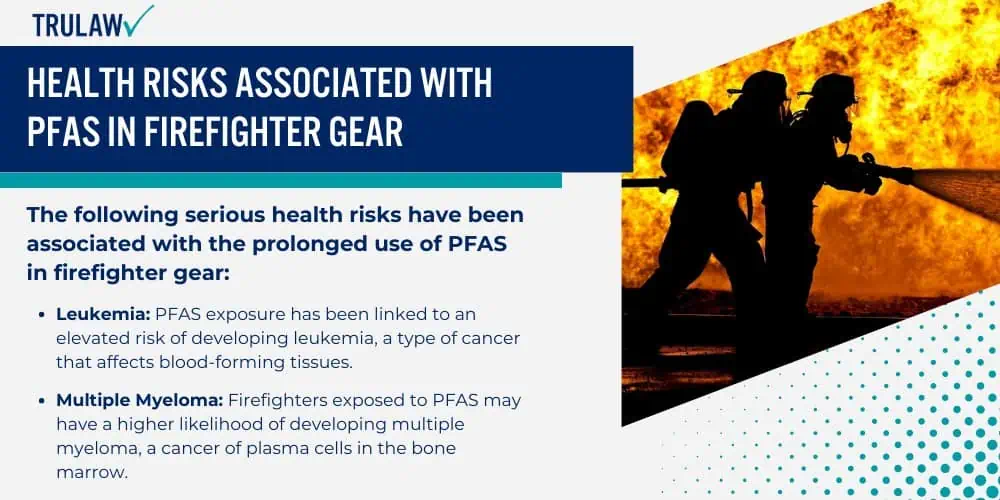
The prolonged use of PFAS-contaminated firefighter gear exacerbates these health risks.
The following serious health risks have been associated with the prolonged use of PFAS in firefighter gear:
- Leukemia: PFAS exposure has been linked to an elevated risk of developing leukemia, a type of cancer that affects blood-forming tissues.
- Multiple Myeloma: Firefighters exposed to PFAS may have a higher likelihood of developing multiple myeloma, a cancer of plasma cells in the bone marrow.
- Non-Hodgkin Lymphoma: Studies suggest that prolonged exposure to PFAS can increase the risk of non-Hodgkin lymphoma, a cancer that originates in the lymphatic system.
Cancer Risks from PFAS Firefighter Gear and Equipment
PFAS exposure has been linked to a heightened risk of developing various types of cancer.
These risks necessitate stringent safety measures and regular health monitoring.
The cancer risks associated with PFAS firefighter gear include, but are not limited to:
- Testicular Cancer: A study by Purdue et al. found a significant association between elevated serum PFOS levels and an increased risk of testicular cancer among U.S. Air Force servicemen.
- Kidney Cancer: Research within the Multiethnic Cohort Study led by Rhee et al. indicated a positive association between elevated levels of PFNA and an increased risk of kidney cancer, especially among African American participants.
- Prostate Cancer: An investigation in the Prostate, Lung, Colorectal, and Ovarian Cancer Screening Trial (PLCO) suggests additional research is necessary to understand the association between PFAS and aggressive prostate cancer.
- Breast Cancer: A nested case-control study within the PLCO cohort found a positive association between serum PFOS concentrations and hormone receptor-positive breast cancer subtypes in postmenopausal women.
- Liver Cancer: Recent research confirmed that exposure to perfluorobutane sulfate (PFOS), a type of PFAS, is linked to an increased risk of hepatocellular carcinoma, the most common type of liver cancer.
- Lung Cancer: PFAS exposure has been associated with lung cancer. A study indicated that exposure to PFOS and PFOA promoted cancer cell migration, a precursor to metastasis, in lung cancer cells.
- Brain Cancer: Emerging evidence suggests a potential link between PFAS exposure and brain cancer.
- Stomach Cancer: A National Cancer Institute study indicated that PFAS exposure can disrupt digestive health and potentially lead to stomach cancer.
- Esophagus Cancer: The carcinogenic potential of PFAS has been linked to cancers of the esophagus, as observed by the Roswell Park Comprehensive Cancer Center.
- Intestinal Cancer: PFAS exposure has been associated with an increased risk of intestinal cancer, with research highlighting the disruption of cellular processes in the intestines.
- Rectal Cancer: A National Cancer Institute study found associations between long-term PFAS-contaminated water exposure and increased risk of rectal cancer.
- Bladder Cancer: Research identified a link between long-term PFAS exposure and elevated risk of bladder cancer, particularly through contaminated drinking water.
- Other serious injuries
Understanding these cancer risks is crucial for advocating for safer working conditions and better protective gear for our firefighters.
Other Health Impacts of PFAS Firefighter Gear
PFAS chemicals also contribute to other health issues affecting firefighters’ overall well-being.
Addressing these impacts can dramatically affect comprehensive health and safety protocols for PFAS chemicals.
Other health impacts of PFAS firefighter gear include, but are not limited to:
- Suppressed immune function and lower vaccine efficacy.
- Hormone disruption and impaired fertility.
- Elevated cholesterol and liver effects.
- Increased risk of thyroid disease and ulcerative colitis.
- Other serious injuries
These health impacts highlight the urgent need for regulatory measures and proactive health monitoring for firefighters.
Uses and Components of PFAS Firefighter Turnout Gear
Firefighter turnout gear, also known as bunker gear, is the protective clothing worn by firefighters.
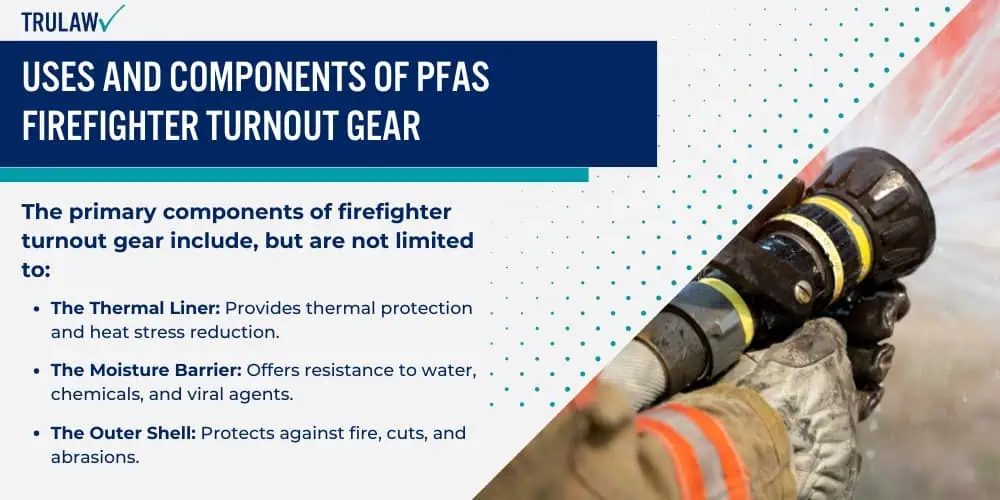
Each set weighs up to 45 pounds and has multiple layers, including a thermal liner, moisture barrier, and outer shell.
Components of PFAS Firefighter Turnout Gear
Turnout gear comprises several components that work together to protect firefighters.
Each component is designed to provide specific protective benefits.
The primary components of firefighter turnout gear include, but are not limited to:
- The Thermal Liner: Provides thermal protection and heat stress reduction.
- The Moisture Barrier: Offers resistance to water, chemicals, and viral agents.
- The Outer Shell: Protects against fire, cuts, and abrasions.
- Various components: Helmets, gloves, hoods, boots, coats, and pants.
Each layer serves specific functions essential for the safety and effectiveness of firefighters.
Purpose and Use of PFAS Firefighter Turnout Gear
Firefighter turnout gear is designed to protect from the intense heat, flames, and hazardous environments they encounter during firefighting operations.
Proper use and maintenance of this gear are critical for ensuring firefighter safety.
Key purposes of PFAS firefighter turnout gear include, but are not limited to:
- Protecting against thermal burns and heat stress.
- Shielding from water and chemical exposure.
- Providing abrasion resistance during physical activities.
- Ensuring overall safety and mobility in hazardous situations.
While designed to protect firefighters, PFAS in firefighting gear raises serious concerns about long-term health effects.
Forever Chemicals: PFAS Firefighter Gear Lawsuit
PFAS, or “forever chemicals,” are a group of compounds known for their stability and resistance to water and heat, making them ideal for use in firefighter uniforms.
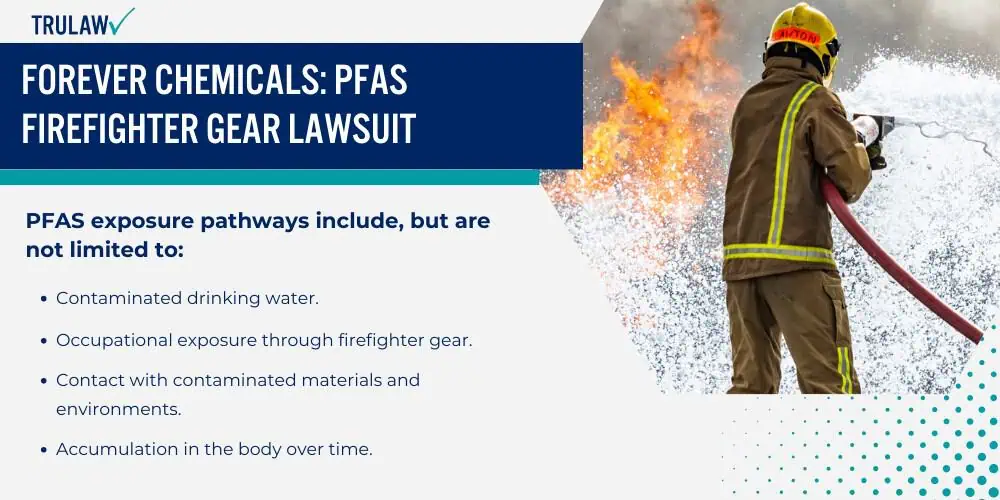
However, studies have shown that PFAS can be shed from the gear over time, exposing firefighters to these harmful substances.
Exposure Pathways from PFAS Firefighter Gear
Firefighters can be exposed to PFAS through various pathways, increasing their risk of health issues.
Awareness of these pathways is essential for developing effective mitigation strategies.
PFAS exposure pathways include, but are not limited to:
- Contaminated drinking water.
- Occupational exposure through firefighter gear.
- Contact with contaminated materials and environments.
- Accumulation in the body over time.
- Other types of exposure
These exposure pathways increase the risk of health issues for firefighters who wear this gear for years.
Shedding and Accumulation of PFAS in Firefighter Gear
Studies indicate that PFAS are likely shedding from the moisture barrier and outer liner through use, posing health risks.
This shedding emphasizes the importance of regular gear inspection and maintenance.
Key points about the shedding and accumulation of PFAS include:
- PFAS accumulates in the body and never breaks down.
- Career firefighters face higher PFAS exposure due to prolonged use.
- Materials closest to the firefighter’s skin gather more PFAS with age.
- More studies are needed to determine the full extent of PFAS shedding.
This ongoing exposure highlights the need for safer alternatives and improved protective gear standards.
Effort To Rid Fire Gear Of PFAS Falls Short
The International Association of Fire Fighters (IAFF) has advocated for removing PFAS from firefighter gear, but efforts to amend uniform standards set by the NFPA have been unsuccessful so far.
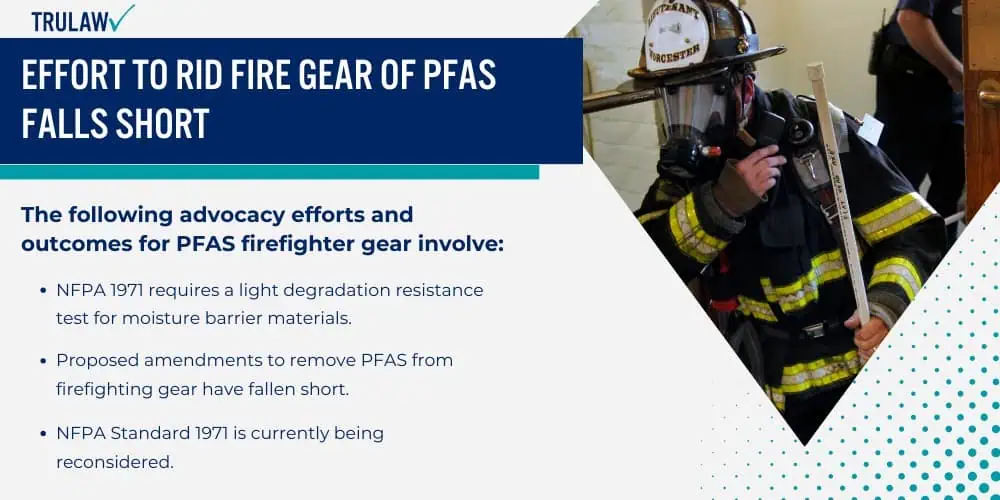
Despite these setbacks, continued advocacy is essential.
Advocacy Efforts for PFAS Firefighter Gear
The IAFF’s efforts to eliminate PFAS from firefighter gear have faced significant challenges.
Engaging with policymakers and stakeholders can help drive necessary changes.
The following advocacy efforts and outcomes for PFAS firefighter gear involve:
- NFPA 1971 requires a light degradation resistance test for moisture barrier materials.
- Proposed amendments to remove PFAS from firefighting gear have fallen short.
- NFPA Standard 1971 is currently being reconsidered.
- Continued advocacy is needed to address the health hazards of PFAS in turnout gear.
Despite setbacks, the fight to protect firefighters from PFAS exposure continues.
Continued Challenges with PFAS Firefighter Gear
There are numerous challenges in addressing PFAS contamination in firefighter gear.
These ongoing challenges require persistent efforts and collaboration across various sectors to provide firefighters and other service men and women with the protective gear they need to stay safe.
Key challenges with PFAS firefighter gear may include:
- Resistance from manufacturers to change existing standards.
- Lack of alternative materials that meet safety and performance requirements.
- Ongoing legal and regulatory battles to enforce stricter safety measures.
- Need for increased awareness and support from the firefighter community.
These challenges underscore the complexity of addressing PFAS contamination in firefighter gear.
Top Manufacturers Of PFAS Firefighter Gear
Several companies manufacture firefighter turnout gear, including DuPont, TenCate, Honeywell, Lion Apparel, Globe Holding Company, Fire-Dex, W.L. Gore Associates, PBI Performance Products, and Quaker Safety Products Corp.
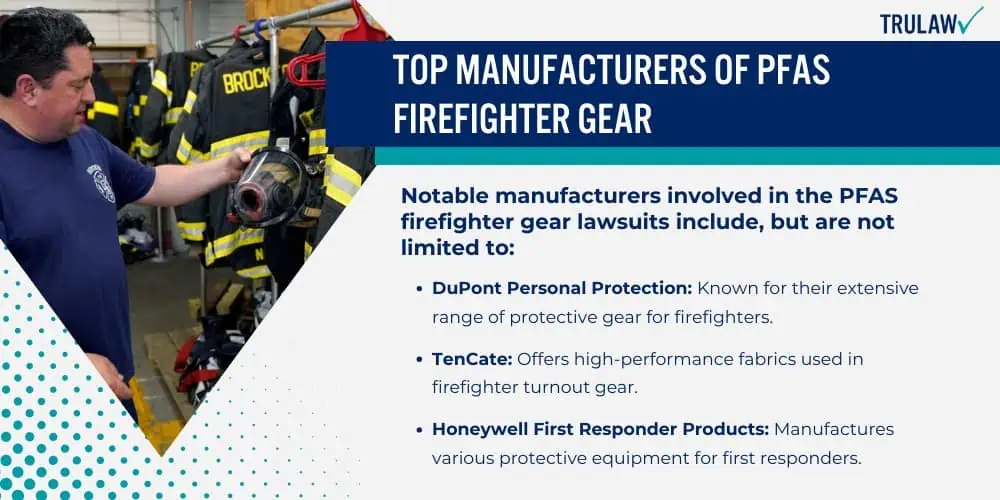
These manufacturers are responsible for ensuring the safety and effectiveness of their products.
Notable Manufacturers of PFAS Firefighter Gear
These manufacturers play a significant role in the production and safety standards of firefighter turnout gear.
Their accountability is crucial in addressing the health risks associated with PFAS.
Notable manufacturers involved in the PFAS firefighter gear lawsuits include, but are not limited to:
- DuPont Personal Protection: Known for their extensive range of protective gear for firefighters.
- TenCate: Offers high-performance fabrics used in firefighter turnout gear.
- Honeywell First Responder Products: Manufactures various protective equipment for first responders.
- Lion Apparel: Produces advanced protective clothing for firefighters.
- Globe Holding Company, LLC: A leading firefighter gear and safety equipment provider.
- Fire-Dex: Specializes in manufacturing turnout gear and other protective apparel.
- W.L. Gore Associates, Inc.: Known for innovative fabric technologies used in protective gear.
- PBI Performance Products: Provides high-performance fibers for use in turnout gear.
- Quaker Safety Products Corp: Offers a range of safety gear and protective equipment.
- Other PFAS manufacturers
Manufacturers’ Role and Responsibility for PFAS Firefighter Gear
Manufacturers have critical responsibilities in ensuring the safety and effectiveness of their products.
Their collaboration with regulatory bodies is vital for the development of safer alternatives.
Ensuring compliance with manufacturing safety standards is essential to protect firefighters.
Key responsibilities of firefighter gear manufacturers include, but are not limited to:
- Ensuring the safety and effectiveness of their products.
- Complying with regulatory standards and guidelines.
- Addressing the health risks associated with PFAS in their products.
- Collaborating with regulatory bodies to find safer alternatives.
These responsibilities are critical in mitigating the risks associated with PFAS exposure in firefighter gear.
Increased Cancer Risk from PFAS Firefighter Gear
Studies have shown that firefighters face a higher risk of cancer compared to the general public, with the CDC reporting that cancer is the leading cause of death among firefighters.
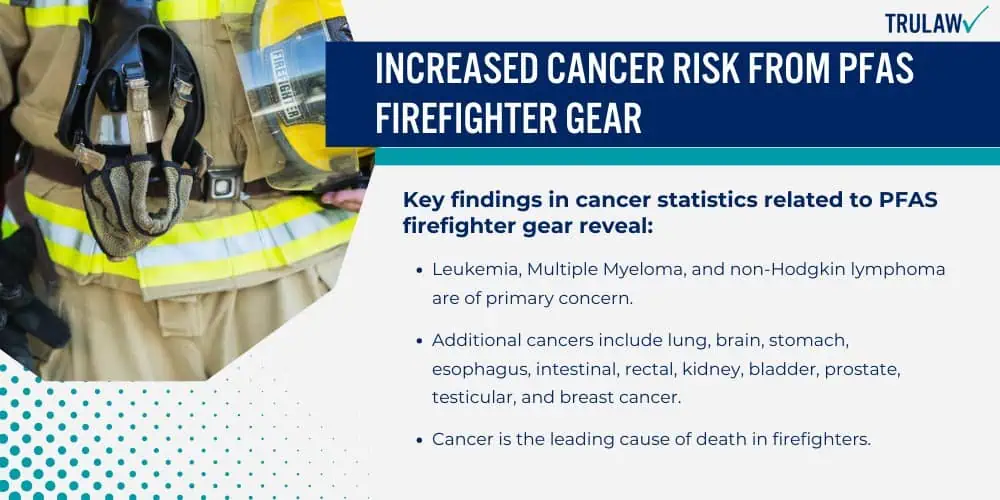
These findings emphasize the urgent need for regulatory measures and health monitoring.
Ongoing research and advocacy are essential to address these risks effectively.
Cancer Statistics Related to PFAS Firefighter Gear
Research highlights the increased cancer risks associated with PFAS exposure in firefighter gear.
Regular health monitoring and preventive measures are essential to address these risks.
Implementing stringent safety protocols can help mitigate these risks.
Key findings in cancer statistics related to PFAS firefighter gear reveal:
- Leukemia, Multiple Myeloma, and non-Hodgkin lymphoma are of primary concern.
- Additional cancers include lung, brain, stomach, esophagus, intestinal, rectal, kidney, bladder, prostate, testicular, and breast cancer.
- Cancer is the leading cause of death in firefighters.
- The study looked at 19,309 male firefighters first hired in 1950 or later.
The link between PFAS exposure from firefighter gear and increased cancer risk is a central issue in the ongoing lawsuits.
Health Monitoring for PFAS Firefighter Gear Exposure
Regular health monitoring is essential for the early detection and management of PFAS-related health issues.
These measures help protect firefighters’ health and ensure early intervention when necessary.
Continuous education and training are crucial for effective health management.
Health monitoring recommendations for PFAS firefighter gear exposure include, but are not limited to:
- Regular health screenings and cancer checks.
- Monitoring of PFAS levels in the blood.
- Proactive health measures to mitigate risks.
- Continuous education on health risks and preventive measures.
These measures help protect firefighters’ health and ensure early intervention when necessary.
St. Andre Particle Accelerator – 2020 Study on PFAS Firefighter Gear
A 2020 study by Professor Graham Peaslee of Notre Dame used a novel technique to detect high levels of fluorine, indicating the presence of PFAS, in firefighter gear.
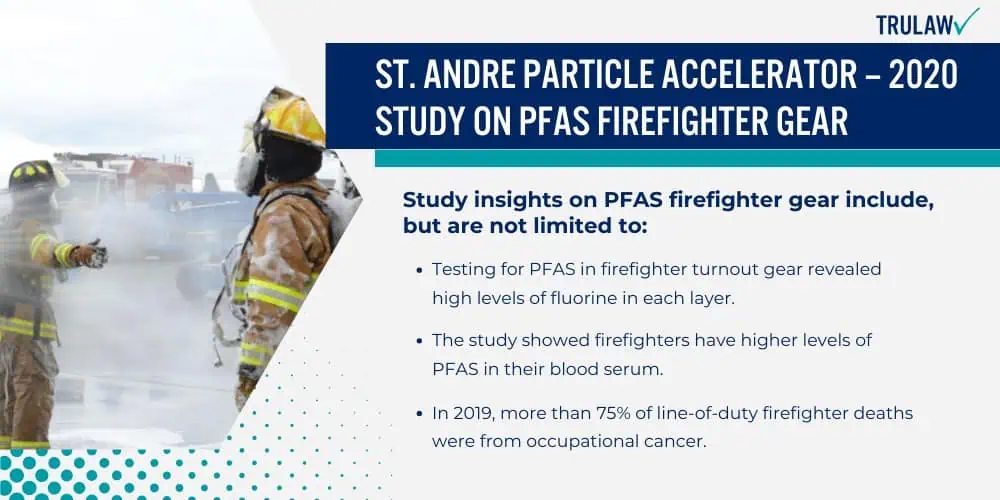
This study provided critical insights into PFAS contamination in firefighter gear.
The findings support the need for ongoing research and policy changes to ensure firefighter safety.
Study Insights on PFAS Firefighter Gear
The study provided critical insights into the levels of PFAS in firefighter gear and its health implications.
These findings support the need for ongoing research and policy changes.
Effective communication of these findings is crucial for raising awareness.
Study insights on PFAS firefighter gear include, but are not limited to:
- Testing for PFAS in firefighter turnout gear revealed high levels of fluorine in each layer.
- The study showed firefighters have higher levels of PFAS in their blood serum.
- In 2019, more than 75% of line-of-duty firefighter deaths were from occupational cancer.
- The study also highlights the need for continued research and advocacy for safer turnout gear.
This study has been instrumental in raising awareness about the risks of PFAS in firefighter gear and supporting the ongoing lawsuits.
Implications of Findings on PFAS Firefighter Gear
The findings from this study have significant implications for firefighter safety and gear manufacturing standards.
Collaboration between researchers, manufacturers, and policymakers is essential.
Implications of PFAS firefighter gear research suggest the following key points:
- Need for immediate action to reduce PFAS exposure.
- Development of PFAS-free alternatives for firefighter gear.
- Implementation of stricter safety standards and regulations.
- Increased funding for research on PFAS and its health impacts.
These implications highlight the importance of addressing PFAS contamination in firefighter gear.
Aqueous Film-Forming Foams (AFFF) Products Liability Litigation MDL No. 2873
In addition to the PFAS firefighter gear lawsuits, multidistrict litigation (MDL) has been formed for cases involving aqueous film-forming foams (AFFF) containing PFAS.
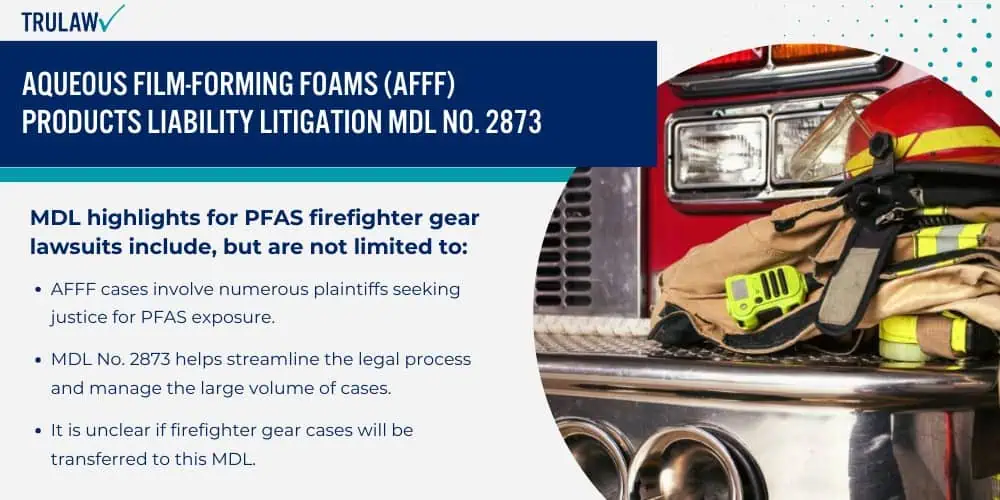
MDL No. 2873 helps streamline the legal process and manage the large volume of cases involving PFAS exposure.
MDL Highlights for PFAS Firefighter Gear Lawsuits
Regular status conferences and case management orders ensure that discovery processes are coordinated efficiently.
This includes mechanisms to address deficient fact sheets and the organization of expert testimony on scientific issues related to PFAS exposure.
MDL highlights for PFAS firefighter gear lawsuits include, but are not limited to:
- AFFF cases involve numerous plaintiffs seeking justice for PFAS exposure.
- MDL No. 2873 helps streamline the legal process and manage the large volume of cases.
- It is unclear if firefighter gear cases will be transferred to this MDL.
- Ongoing legal proceedings aim to address the health impacts of PFAS exposure.
The AFFF MDL and the PFAS firefighter gear lawsuits represent a concerted effort to hold manufacturers accountable for the harmful effects of PFAS.
The MDL for AFFF-related cases is centralized in the District of South Carolina under the supervision of Judge Richard M. Gergel.
The cases primarily concern contamination from AFFF at military bases, airports, and other industrial sites, where plaintiffs allege personal injury, property damage, and economic losses due to PFAS exposure
This coordination helps to prevent conflicting rulings and facilitates comprehensive settlements that address the collective harm caused by PFAS exposure.
Legal Proceedings for the PFAS Firefighter Gear Lawsuit
These legal proceedings are crucial for achieving justice and compensation for affected firefighters.
The outcomes will set precedents for future cases involving PFAS exposure.
Active participation and advocacy are essential for successful legal outcomes.
Key points about legal proceedings for PFAS firefighter gear lawsuits include, but are not limited to:
- Coordination of efforts across multiple jurisdictions.
- Collection and presentation of scientific evidence.
- Negotiations for settlements and compensations.
- Advocacy for policy changes and regulatory enforcement.
These legal proceedings aim to address the significant health impacts of PFAS exposure on firefighters.
Recent legislative actions, such as the PFAS Alternatives Act, demonstrate the commitment to developing PFAS-free turnout gear and mitigating exposure risks.
These efforts are supported by comprehensive studies that reveal how PFAS in firefighter gear can increase due to wear and tear, highlighting the need for safer alternatives.
Additionally, ongoing research and advocacy conducted by the U.S. Fire Administration focuses on implementing policy changes to enhance firefighters’ protection from harmful PFAS chemical exposure.
Individual PFAS Firefighter Gear Lawsuit
Currently, individual PFAS firefighter gear lawsuits are being filed in state courts across the country on behalf of firefighters diagnosed with cancer rather than class action lawsuits.
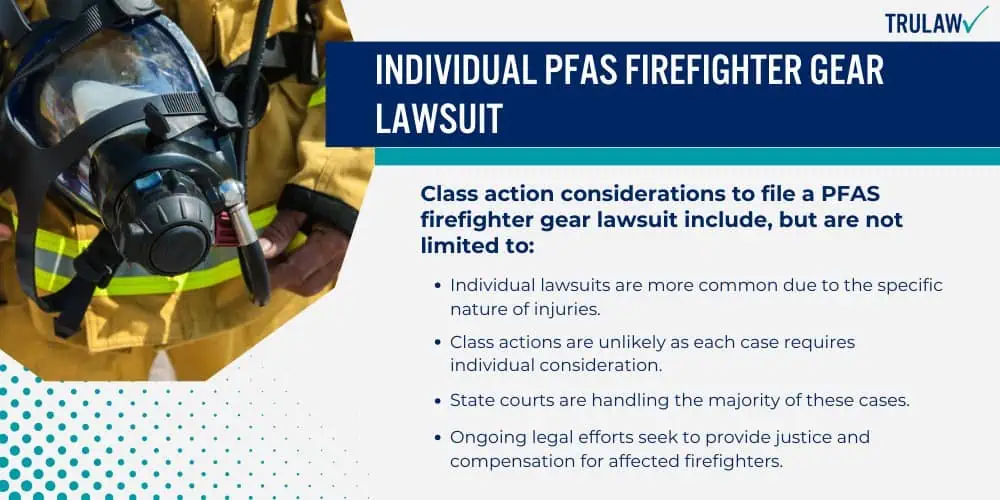
These lawsuits focus on specific injuries and personal circumstances.
Effective legal representation is crucial for achieving justice.
Class Action Considerations for Filing a PFAS Firefighter Gear Lawsuit
Individual lawsuits are more common due to the specific nature of injuries, but there are important considerations for potential class actions.
Each approach has its unique benefits and challenges.
Class action considerations to file a PFAS firefighter gear lawsuit include, but are not limited to:
- Individual lawsuits are more common due to the specific nature of injuries.
- Class actions are unlikely as each case requires individual consideration.
- State courts are handling the majority of these cases.
- Ongoing legal efforts seek to provide justice and compensation for affected firefighters.
TruLaw, a nationally recognized law firm, actively represents firefighters in these PFAS firefighter gear lawsuits, fighting to ensure our heroes receive the justice they deserve.
Individual vs. Class Action for a PFAS Firefighter Gear Lawsuit
Understanding the differences between individual lawsuits and class actions helps choose the appropriate legal approach for each case.
Each approach has its unique benefits and challenges.
Key differences in an individual and class action PFAS firefighter gear lawsuit include, but are not limited to:
- Individual lawsuits focus on specific injuries and personal circumstances.
- Class actions address broader issues affecting a large group.
- Individual cases allow for tailored legal strategies and compensations.
- Class actions provide collective bargaining power and streamlined processes.
These distinctions are important for determining the best legal strategy for affected firefighters.
Preventative Measures for PFAS Firefighter Gear
The San Francisco Firefighters Cancer Prevention Foundation has recommended several measures to reduce exposure to PFAS.
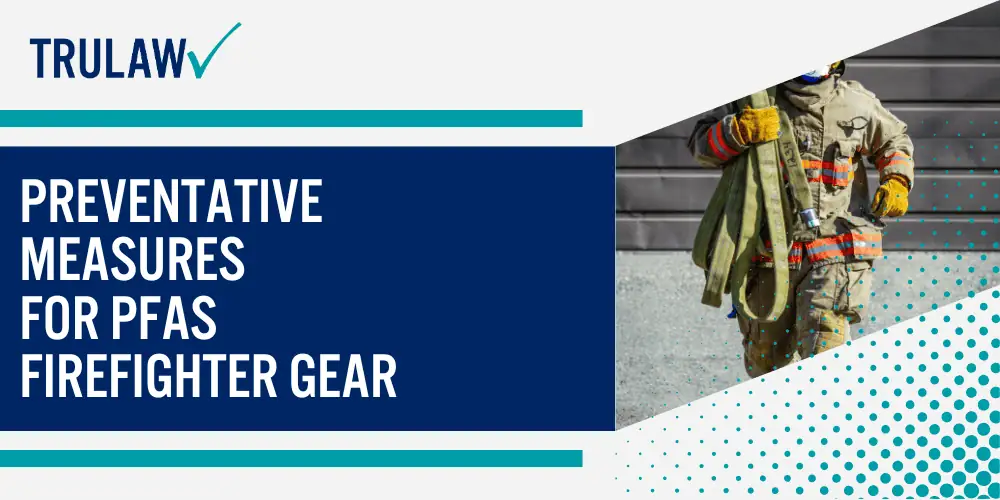
In addition to these recommendations, San Francisco lawmakers are taking legal action to pass an ordinance prohibiting protective equipment made with per- and poly-fluoroalkyl substances, or PFAS.
Preventative Measures for PFAS Firefighter Gear
Firefighters can take key preventative measures to minimize their exposure to PFAS.
These steps are crucial for long-term health and safety.
Key preventative measures for PFAS firefighter gear include:
- Keep wearing the gear, as there is currently no alternative.
- Treat PPE with respect and use it only for fires.
- Keep gear separate from your kids and living areas.
- Wash the gear before you wear it.
These measures are essential for minimizing PFAS exposure and protecting firefighter health.
Proactive Actions for PFAS Firefighter Gear
In addition to preventative measures, proactive steps can be taken to mitigate the risks associated with PFAS exposure in firefighter gear.
Proactive actions ensure better protection and long-term solutions.
Recommended actions to reduce PFAS in firefighter gear include, but are not limited to:
- Support studies to determine dermal absorption of PFAS.
- Explore alternative PPE treatments.
- Conduct dust analysis to understand PFAS degradation.
- Advocate for legislative changes to regulate PFAS in PPE.
These actions, combined with the ongoing legal efforts through the PFAS firefighter gear lawsuits, contribute toward ensuring the safety and well-being of our firefighters.
Legislative Actions for PFAS Firefighter Gear
Legislative efforts to address the regulatory gaps surrounding PFAS and firefighter gear are necessary to protect service men and women.
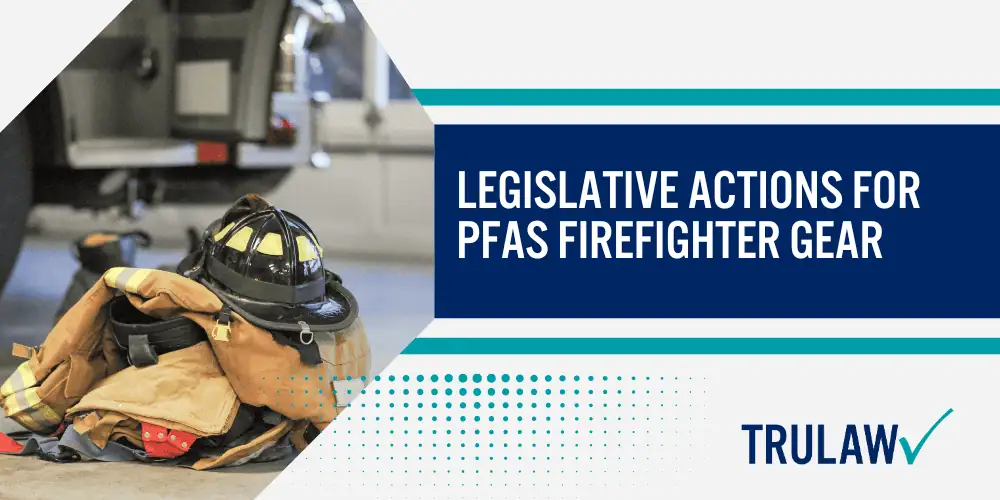
Advocacy and Policy Change for PFAS Firefighter Gear
Advocacy and policy changes are essential to ensure the safety of firefighters from PFAS exposure.
Collaborative efforts can lead to meaningful regulatory improvements.
Key legislative actions targeting PFAS firefighter gear focus on the following topics:
- Push for Congress to establish a First Responders PFAS Task Force.
- Mandate PPE companies to disclose the percentage of PFAS used.
- Create a maximum limit for PFAS in PPE.
- Advocate for changes in NFPA standards to eliminate PFAS in gear.
By working together to enact these legislative changes, we can create a safer environment for our firefighters and protect them from the harmful effects of PFAS exposure.
Ongoing Legislative Efforts for PFAS Firefighter Gear
Ongoing legislative efforts are crucial to ensure comprehensive regulatory coverage and protection for firefighters.
These efforts need sustained support and active participation.
Collaboration across sectors is vital for success.
Ongoing legislative efforts to ban PFAS in firefighter gear include, but are not limited to:
- Collaboration with lawmakers and regulatory bodies.
- Public awareness campaigns to highlight the risks of PFAS.
- Lobbying for stricter regulations and enforcement.
- Support for research and development of safer alternatives.
These efforts aim to ensure long-term protection and safety for firefighters.
Understanding PFAS in Firefighter Gear
PFAS, or per and polyfluoroalkyl substances, are a group of over 12,000 chemicals used in various products for nearly 70 years.
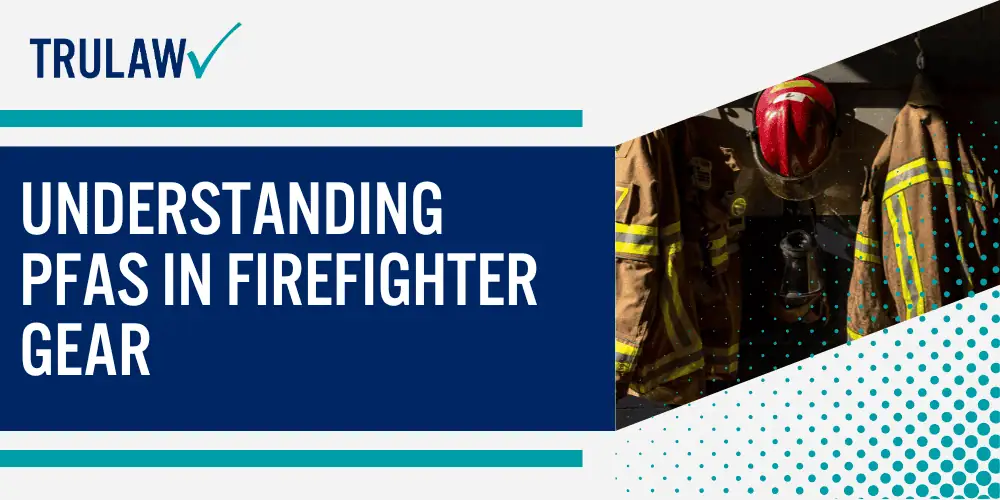
These “forever chemicals” are found in the blood of 98% of people and have been linked to numerous health risks.
Key Facts About PFAS in Firefighter Gear
PFAS are widely used in firefighter gear due to their stability and resistance to heat and water.
Recent studies by the National Institute of Standards and Technology (NIST) have shown that the amount of PFAS in firefighter gear varies widely between manufacturers and layers, with the highest concentrations found in the outermost layers of the gear.
The study suggests that selecting optimal fabric combinations for each layer could significantly reduce the amount of PFAS present.
Awareness of these facts is vital for informed decision-making and risk management.
Key facts about PFAS in firefighter gear include, but are not limited to:
- PFAS are used to make non-stick, grease-resistant, stain-resistant, flame retardant, and water-proofing materials.
- High levels of PFAS have been found in firefighting gear, consumer products, food sources, and contaminated drinking water.
- PFAS exposure can lead to various health conditions such as suppressed immune function, thyroid disease, testicular and kidney cancers, and elevated cholesterol.
- Production, use, and levels of PFAS in drinking water are not federally regulated, leading to continued exposure and health risks.
The harmful nature of PFAS and the associated health risks emphasize the importance of the ongoing PFAS firefighter gear lawsuits in seeking justice for affected firefighters.
Health Impacts of PFAS Firefighting Gear
PFAS exposure has been linked to a wide range of health conditions, making additional health monitoring crucial, especially for occupationally exposed groups like firefighters.
Regular screenings and preventive actions can help manage these health impacts effectively.
Health impacts of PFAS firefighting gear include, but are not limited to:
- Immune suppression and lower vaccine efficacy.
- Elevated cholesterol and liver effects.
- Impaired fertility and hormone disruption.
- Increased risk of cancers such as testicular and kidney cancer.
- Other serious health conditions
Studies have shown that PFAS can be released from gear through regular wear and tear, leading to increased exposure risks for firefighters.
Efforts are being made to develop PFAS-free alternatives and improve regulatory measures to protect firefighters from these harmful substances.
These health impacts highlight the urgent need for regulatory measures, proactive health monitoring, and ongoing legal efforts through the PFAS firefighter gear lawsuits.
Reducing Exposure to PFAS in Firefighter Gear
Until PFAS-free alternatives are available, firefighters can take steps to reduce their exposure to these harmful chemicals in their turnout gear.
Continuous education and training are essential for effective implementation.
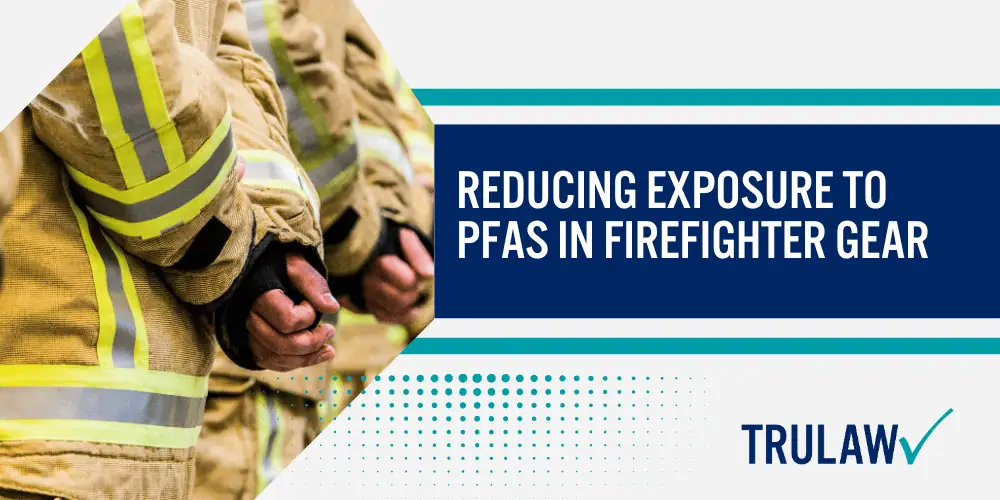
These chemicals, known for their resistance to water and oil, enhance the gear’s durability and effectiveness.
However, their persistence in the environment and potential health risks have raised significant concerns
Guidelines for Reducing Exposure to PFAS in Firefighter Gear
Firefighters can follow these guidelines to minimize their exposure to PFAS.
Consistent adherence to these guidelines is vital for health protection.
The variability in PFAS concentrations among different manufacturers and layers of firefighter gear emphasizes the need for standardized regulations and better material choices to reduce PFAS levels
Guidelines for reducing exposure to PFAS in firefighter gear include, but are not limited to:
- Only wear firefighter turnout gear when it is necessary.
- Store turnout gear in an enclosed, designated area.
- Thoroughly clean contaminated turnout gear.
- Use hazard zone designations at the station.
- Conduct regular PFAS exposure assessments for firefighters to monitor and manage potential health risks.
By following these guidelines and supporting the efforts of law firms like TruLaw in the PFAS firefighter gear lawsuits, we can work towards a safer future for our firefighters.
Additional Precautions for PFAS Firefighter Gear
Additional precautions help further reduce the risk of PFAS exposure.
Implementing these precautions is crucial for comprehensive safety.
Additional precautions for PFAS firefighter gear include, but are not limited to:
- Wash hands with soap and water after handling gear.
- Avoid taking gear home to prevent cross-contamination.
- Ensure that PFAS-free alternatives are prioritized in procurement processes whenever available.
- Regularly inspect gear for signs of degradation.
- Educate firefighters on the risks and safety measures related to PFAS.
These precautions help minimize exposure and protect firefighter health.
PFAS Blood Testing for Firefighters
Firefighters concerned about PFAS exposure can request specific blood tests from their healthcare providers to measure the level of PFAS in their blood.
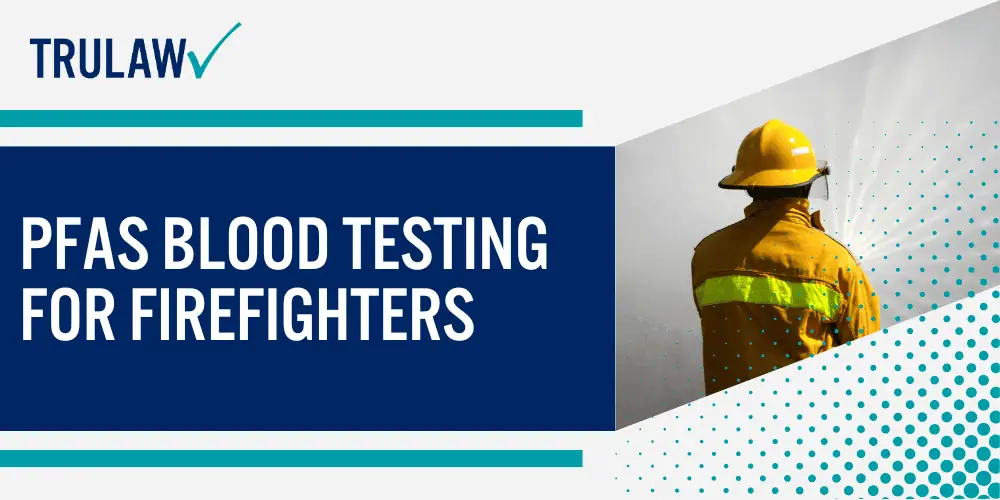
Early detection can help in taking necessary preventive measures.
Health Screening Recommendations for PFAS Firefighter Gear
Regular health screenings are crucial for early detection of PFAS-related health issues.
These screenings should be integrated into routine health checks for firefighters.
Health screening recommendations for PFAS exposure include, but are not limited to:
- Monitor cholesterol levels regularly.
- Check for testicular cancer as part of your regular physical.
- Discuss additional basic tests with your doctor based on current medical screening guidance for PFAS.
- Share any occupational exposure concerns with your healthcare provider.
Regular health monitoring is crucial for early detection and management of PFAS-related health issues.
Testing Procedures for PFAS Firefighter Gear
Specific testing procedures ensure accurate assessment and management of PFAS exposure.
Regular follow-up is crucial for managing long-term health risks.
Testing procedures for PFAS firefighter gear exposure may include:
- Providers should use ICD-10 diagnosis code Z13.88 for PFAS exposure.
- If ordering a test through Quest, use Test Code 39307 and CPT Code 82542.
- Ensure certified laboratories conduct tests.
- Follow up on test results with appropriate medical advice and treatment.
These procedures ensure accurate assessment and effective management of PFAS exposure.
Regular follow-up testing is important to monitor the development of long-term health risks.
IAFF Initiatives for PFAS Firefighter Gear
The International Association of Fire Fighters (IAFF) has been actively working to address the issue of PFAS in firefighter turnout gear and the associated health risks.

Their initiatives are critical for advancing firefighter safety standards.
Continued advocacy and collaboration are vital for achieving these goals.
IAFF Efforts to Combat PFAS in Firefighter Gear
The IAFF is committed to combating PFAS exposure and protecting firefighters.
Their initiatives are critical for advancing firefighter safety standards.
The initiatives led by the IAFF include, but are not limited to:
- The IAFF was among the first organizations to alert members of the health risks of PFAS in turnout gear.
- Advocating for precautionary steps for members and departments until next-generation turnout gear can be developed.
- Continuing to push for legislative changes and safer alternatives for firefighter gear.
The IAFF’s commitment to member health and safety is unwavering, and they continue to work tirelessly to protect firefighters from the dangers of PFAS exposure.
Future Directions for PFAS Firefighter Gear
The IAFF is focused on several future directions to ensure firefighter safety.
These initiatives aim to create a safer working environment for firefighters nationwide.
Future directions for PFAS firefighter gear include, but are not limited to:
- Developing PFAS-free turnout gear options.
- Expanding research on the health impacts of PFAS.
- Strengthening collaboration with regulatory agencies.
- Enhancing education and training programs for firefighters.
These efforts aim to ensure long-term protection and safety for firefighters.
TruLaw: The #1 PFAS Firefighter Gear Lawyer
If you are a firefighter who has developed health issues potentially related to PFAS exposure from firefighter gear, you may have legal options for seeking compensation.
TruLaw specializes in chemical exposure litigation representing firefighters affected by PFAS, ensuring you get the justice and compensation you deserve.
Why Choose TruLaw?
- Expertise in PFAS Cases: Our team is well-versed in the complexities of PFAS-related legal issues.
- Proven Track Record: We have successfully represented numerous firefighters in similar cases.
- Dedicated Support: From the initial consultation to the final verdict, we are with you every step of the way.
- No Upfront Fees: You don’t pay unless we win your case.
We understand the unique challenges faced by firefighters exposed to PFAS and is committed to fighting for your rights.
Our experienced chemical exposure attorneys are ready to provide you with the dedicated representation you need to overcome the challenges of pursuing compensation for your damages.
Contact TruLaw using the chat on this page to receive a free case review and learn more about your eligibility to file a PFAS firefighter gear lawsuit.
Firefighter Turnout Gear Lawsuit Frequently Asked Questions
-
While efforts are underway to develop PFAS-free gear, no viable alternatives currently meet the necessary safety standards set by the National Fire Protection Association.
-
The amount of PFAS present varies widely in different types of personal protective equipment (PPE), also called turnout gear, varies widely.
Studies by the National Institute of Standards and Environmental Protection Agency have found the highest PFAS concentrations in the gear’s moisture barrier layer.
-
Firefighters face an increased risk of various cancers, including testicular, kidney, liver, and breast cancer, as well as leukemia, multiple myeloma, and non-Hodgkin lymphoma.
PFAS exposure can also lead to suppressed immune function, hormone disruption, and elevated cholesterol levels.
-
The International Association of Fire Fighters (IAFF) has advocated for removing PFAS from firefighter gear, but efforts to amend uniform standards set by the National Fire Protection Association have been unsuccessful.
To achieve safer standards, advocacy and collaboration between regulatory bodies and PFAS manufacturers must be urgent.
-
Firefighters can take preventative measures to minimize their exposure to PFAS, such as only wearing turnout gear when necessary, treating their protective equipment with respect, keeping turnout gear separate from living areas, and washing gear before wearing it.
Regular health screenings and blood tests are paramount for early detection and management of PFAS-related health issues.

Managing Attorney & Owner
With over 25 years of legal experience, Jessica Paluch-Hoerman is an Illinois lawyer, a CPA, and a mother of three. She spent the first decade of her career working as an international tax attorney at Deloitte.
In 2009, Jessie co-founded her own law firm with her husband – which has scaled to over 30 employees since its conception.
In 2016, Jessie founded TruLaw, which allows her to collaborate with attorneys and legal experts across the United States on a daily basis. This hypervaluable network of experts is what enables her to share the most reliable, accurate, and up-to-date legal information with our readers!
Additional Firefighter Turnout Gear Lawsuit resources on our website:
Here, at TruLaw, we’re committed to helping victims get the justice they deserve.
Alongside our partner law firms, we have successfully collected over $3 Billion in verdicts and settlements on behalf of injured individuals.
Would you like our help?
At TruLaw, we fiercely combat corporations that endanger individuals’ well-being. If you’ve suffered injuries and believe these well-funded entities should be held accountable, we’re here for you.
With TruLaw, you gain access to successful and seasoned lawyers who maximize your chances of success. Our lawyers invest in you—they do not receive a dime until your lawsuit reaches a successful resolution!
AFFF Lawsuit claims are being filed against manufacturers of aqueous film-forming foam (AFFF), commonly used in firefighting.
Claims allege that companies such as 3M, DuPont, and Tyco Fire Products failed to adequately warn users about the potential dangers of AFFF exposure — including increased risks of various cancers and diseases.
Depo Provera Lawsuit claims are being filed by individuals who allege they developed meningioma (a type of brain tumor) after receiving Depo-Provera birth control injections.
A 2024 study found that women using Depo-Provera for at least 1 year are five times more likely to develop meningioma brain tumors compared to those not using the drug.
Suboxone Tooth Decay Lawsuit claims are being filed against Indivior, the manufacturer of Suboxone, a medication used to treat opioid addiction.
Claims allege that Indivior failed to adequately warn users about the potential dangers of severe tooth decay and dental injuries associated with Suboxone’s sublingual film version.
Social Media Harm Lawsuits are being filed against social media companies for allegedly causing mental health issues in children and teens.
Claims allege that companies like Meta, Google, ByteDance, and Snap designed addictive platforms that led to anxiety, depression, and other mental health issues without adequately warning users or parents.
Transvaginal Mesh Lawsuits are being filed against manufacturers of transvaginal mesh products used to treat pelvic organ prolapse (POP) and stress urinary incontinence (SUI).
Claims allege that companies like Ethicon, C.R. Bard, and Boston Scientific failed to adequately warn about potential dangers — including erosion, pain, and infection.
Bair Hugger Warming Blanket Lawsuits involve claims against 3M — alleging their surgical warming blankets caused severe infections and complications (particularly in hip and knee replacement surgeries).
Plaintiffs claim 3M failed to warn about potential risks — despite knowing about increased risk of deep joint infections since 2011.
Baby Formula NEC Lawsuit claims are being filed against manufacturers of cow’s milk-based baby formula products.
Claims allege that companies like Abbott Laboratories (Similac) and Mead Johnson & Company (Enfamil) failed to warn about the increased risk of necrotizing enterocolitis (NEC) in premature infants.
Here, at TruLaw, we’re committed to helping victims get the justice they deserve.
Alongside our partner law firms, we have successfully collected over $3 Billion in verdicts and settlements on behalf of injured individuals.
Would you like our help?
